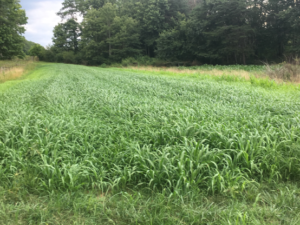Grazing Summer Annual Grasses
go.ncsu.edu/readext?693280
en Español / em Português
El inglés es el idioma de control de esta página. En la medida en que haya algún conflicto entre la traducción al inglés y la traducción, el inglés prevalece.
Al hacer clic en el enlace de traducción se activa un servicio de traducción gratuito para convertir la página al español. Al igual que con cualquier traducción por Internet, la conversión no es sensible al contexto y puede que no traduzca el texto en su significado original. NC State Extension no garantiza la exactitud del texto traducido. Por favor, tenga en cuenta que algunas aplicaciones y/o servicios pueden no funcionar como se espera cuando se traducen.
Português
Inglês é o idioma de controle desta página. Na medida que haja algum conflito entre o texto original em Inglês e a tradução, o Inglês prevalece.
Ao clicar no link de tradução, um serviço gratuito de tradução será ativado para converter a página para o Português. Como em qualquer tradução pela internet, a conversão não é sensivel ao contexto e pode não ocorrer a tradução para o significado orginal. O serviço de Extensão da Carolina do Norte (NC State Extension) não garante a exatidão do texto traduzido. Por favor, observe que algumas funções ou serviços podem não funcionar como esperado após a tradução.
English
English is the controlling language of this page. To the extent there is any conflict between the English text and the translation, English controls.
Clicking on the translation link activates a free translation service to convert the page to Spanish. As with any Internet translation, the conversion is not context-sensitive and may not translate the text to its original meaning. NC State Extension does not guarantee the accuracy of the translated text. Please note that some applications and/or services may not function as expected when translated.
Collapse ▲Many livestock producers use summer annuals to supplement or enhance summer grazing. Sudex or sorghum-sudan hybrids, sudangrass and Pearl millet are the most used varieties.
Much of the sudangrass and sorghum-sudan grasses planted this spring will be ready to graze soon, so producers should keep in mind they contain a compound called prussic acid that can be toxic. Prussic acid often is higher during dry weather so use a few precautions to avoid problems.
The highest concentration of prussic acid is in young shoots, so let the grass get a head start before grazing to help dilute out the prussic acid. Begin grazing sudangrass at about 18 inches in height, but wait until sorghum-sudan hybrids are 20 to 24 inches tall before grazing, as they typically contain higher prussic acid levels. If using pearl millet, there is no need for these precautions because it does not contain prussic acid. Pearl millet can be grazed when it reaches 12 to 15 inches tall.
Summer annual grasses work best with a simple, rotational grazing system. Divide fields into smaller paddocks that will allow grazing for 7-10 days. Graze grass down to about 8 inches of stubble then move to the next paddock. Repeat this procedure with all paddocks. If grass gets too tall, either harvest it for hay or rotate animals more quickly to prevent it from heading.
It’s best not to turn hungry animals into sudangrass or sorghum-sudan pastures. They may eat so rapidly that they could get an overdose of prussic acid.
With a well-planned start, pasture rotation and some needed rain, you can have abundant forage for the rest of the summer.





